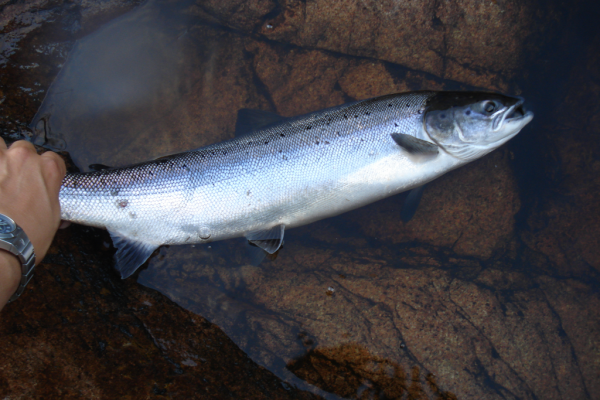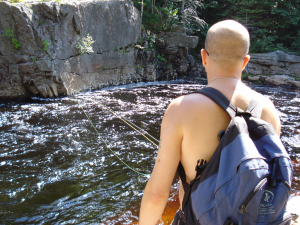 Atlantic salmon are considered by many to be the kings of sport fish. Summer run fish are the epitome of this as they are fresh from the ocean, in optimum condition, and water temperatures are usually perfect in the early part of the summer. If you are lucky enough to hook into one you are in for a fight like no other with blistering knuckle breaking runs and heart pounding leaps. Summer salmon fishing begins on June 1st on Cape Breton Island.
Atlantic salmon are considered by many to be the kings of sport fish. Summer run fish are the epitome of this as they are fresh from the ocean, in optimum condition, and water temperatures are usually perfect in the early part of the summer. If you are lucky enough to hook into one you are in for a fight like no other with blistering knuckle breaking runs and heart pounding leaps. Summer salmon fishing begins on June 1st on Cape Breton Island.
Equipment
Most people use 8 1/2 or 9 foot 8/9 weight single-handed rods. Floating weight forward or double taper lines are the norm. A suitable reel with a disc drag and lots of backing is essential, and a pair of polarized sunglasses.
The flies and presentation
Wet Flies
Wet fly fishing is arguably the most productive method to hook a fish. Fly size depends on water levels. In high water you can fish flies as big as size 2 and in low water as small as size 12. Observation and instinct play a large part in fly selection. Some people say bright flies for bright days and dark flies for dark days. This is a good rule to follow to get you going but I have seen it broken before.
Entire books have been written on presentation. Here is a summary of some rules I follow. If there is a good flow at the head of the pool you can cast at a 45-degree angle downstream and let the fly swing towards you. Once the fly is on the dangle directly below you, take a step downstream to cover all the water in the pool, and to follow salmon fishing etiquette if there are other anglers waiting their turn. If the flow is particularly fast it is a good idea to do a small upstream mend to slow down the swing of the fly. There is a certain speed that Atlantic’s like to see the fly moving at most of the time and this is something that can only be learned through experience. Also it is sometimes good to let the fly hang over a known salmon lie. As the water slows near the main part of the pool you may need to speed up the fly to achieve the motion they like. I do this by adding a figure eight retrieve as the fly is swinging and sometimes moving your rod tip away from the river as well. In very slow water some fishermen will tuck the rod under their arm and do a two handed retrieve to entice Atlantic’s to take.
Some summer wet flies I use are a blue charm, yellow cosseboom, butterfly, black bear green butt, black bear yellow butt, coburn special, green highlander, rusty rat, and a green machine.
Dry Flies
Although dry fly fishing may not be the most productive way to fish for Atlantics, it can have its moments, and it is definitely the most exciting way to hook a fish. Watching your fly and seeing a fish come to it is in my opinion as good as it gets.
Fly size again depends on water levels but I have seen fish come up to big dries in low water so experiment. Never forget the mantra; “raise him on a dry and hook him on a wet.” While fishing the dry fly it pays to work the water close too you with an upstream or downstream presentation on a dead drift, and gradually lengthen your line to cover the water on the other side of the pool. Then take a step downstream and repeat the process, the same as wet fly fishing. A the end of the drift it is a good idea to do a gentle upstream mend and skate your fly across the water. Some salmon like this.
Some dry flies I use are a yellow tail buck bug, brown buck bug, white wulff, and a brown bomber.
I couldn’t possibly provide all the information that exists on fishing for summer run Atlantic salmon, nor do I claim to know it all, but I hope this helps you in your fishing this year.

